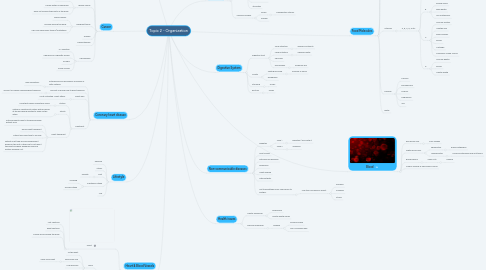
1. Plant organ system
1.1. Roots
1.1.1. Absorb nutrients
1.2. Leaves
1.2.1. Site of photosynthesis and transpiration
1.3. Stem
1.3.1. Transports nutrients
1.4. Flower
1.4.1. Reproduction
1.5. Shoot system
1.5.1. Above ground
2. Heart & Blood Vessels
2.1. Heart
2.1.1. Left Ventricle
2.1.2. Right ventricle
2.1.3. Pumps blood around the body
2.2. Blood vessels
2.2.1. Veins
2.2.1.1. To the heart
2.2.1.2. Pulmonary vein
2.2.1.2.1. Away from heart
2.2.1.3. Low pressure
2.2.1.4. Thin walls
2.2.1.5. One way valve system
2.2.2. Artery
2.2.2.1. From the heart
2.2.2.2. Pulmonary Artery
2.2.2.2.1. Away from heart
2.2.2.3. High pressure
2.2.2.4. Thick walls
2.2.3. Capillaries
2.2.3.1. One cell thick
2.2.3.2. Between veins and heart
2.2.3.3. Where gas exchange takes place
3. Cancer
3.1. A non-communicable disease
3.2. Cells grow and divide uncontrollably
3.3. Benign Tumor
3.3.1. Grows slowly
3.3.2. Usually within a membrane
3.3.3. Does not invade other parts of the body
3.4. Malignant tumor
3.4.1. Grows quickly
3.4.2. Spreads around the body
3.4.3. Can form secondary tumors (metastasis
3.5. Surgery
3.6. Chemotherapy
3.7. Carcinogens
3.7.1. UV radiation
3.7.2. Chemicals ie Cigarette smoke
3.7.3. Alcohol
3.7.4. Some viruses
4. Lifestyle
4.1. Exercise
4.2. Stress
4.3. Diet
4.3.1. Obesity
4.4. Substance intake
4.4.1. Smoking
4.4.2. Alcohol intake
4.5. Job
5. Coronary heart disease
5.1. Arteries become blocked by a buildup of fatty material
5.1.1. Bad cholesterol
5.2. Amount of blood flow to heart reduced
5.2.1. Amount of oxygen reaching heart reduced
5.3. Chest pain
5.3.1. If left untreated : heart attack
5.4. Treatment
5.4.1. Statins
5.4.1.1. Drug that lowers cholesterol levels
5.4.2. Stents
5.4.2.1. Cather is inserted into artery with a balloon at the end which inflates to open up the artery.
5.4.3. Heart transplant
5.4.3.1. Artificial hearts used to temporarily keep patient alive
5.4.3.2. Donor heart transplant
5.4.3.3. Patient will need time to recover
5.4.3.4. Patient must take immunosuppressant drugs for the rest of their life to not reject the heart and have weakened immune system because of it.
6. Food Molecules
6.1. Carbohydrates
6.1.1. Starch
6.1.2. Glucose
6.1.3. ENERGY
6.2. Lipids
6.2.1. High energy density storage
6.3. Proteins
6.3.1. Broken down into amino acids
6.4. Vitamins
6.4.1. A, B, C, D, E etc
6.4.1.1. A
6.4.1.1.1. Growth and development
6.4.1.1.2. Good vision
6.4.1.1.3. Immune health
6.4.1.2. B
6.4.1.2.1. Energy levels
6.4.1.2.2. Brain health
6.4.1.2.3. Cell metabolism
6.4.1.3. C
6.4.1.3.1. Immune system
6.4.1.3.2. Healthy skin
6.4.1.3.3. Blood vessels
6.4.1.3.4. Bones
6.4.1.3.5. Cartilage
6.4.1.3.6. Deficiency called Scurvy
6.4.1.4. D
6.4.1.4.1. Immune health
6.4.1.4.2. Bones
6.4.1.4.3. Mental health
6.5. Minerals
6.5.1. Calcium
6.5.2. Phosphorous
6.5.3. Sodium
6.5.4. Magnesium
6.5.5. Iron
6.6. Water
7. Digestive System
7.1. Digestive tract
7.1.1. Small intestine
7.1.1.1. Absorbs Nutrients
7.1.2. Large intestine
7.1.2.1. Absorbs Water
7.1.3. Pancreas
7.1.4. Gall Bladder
7.1.4.1. Produces bile
7.2. Mouth
7.2.1. Teeth grind food
7.2.1.1. Amylase in saliva
7.2.2. Esophagus
7.3. Stomach
7.3.1. Acidic
7.4. Rectum
7.4.1. Feces
8. Plant tissues
8.1. Leaves
8.1.1. Waxy cuticle
8.1.2. Upper epidermis
8.1.3. Palisade layer
8.1.4. Spongy mesophyl
8.1.5. Lower epidermis
8.1.6. Stomatae
8.2. Vascular bundles
8.2.1. Xylem
8.2.1.1. Transpiration stream
8.2.2. Phloem
9. Non-communicable diseases
9.1. Diabetes
9.1.1. Type 1
9.1.1.1. Inherited / born with it
9.1.2. Type 2
9.1.2.1. Acquired
9.2. Most cancer
9.3. Autoimmune diseases
9.4. Parkinsons
9.5. Heart disease
9.6. Osteoarthritis
9.7. Not transmittable from one person to another.
9.7.1. Life style can have an effect
9.7.1.1. Drinking
9.7.1.2. Smoking
9.7.1.3. Stress
10. Health issues
10.1. Mental Wellbeing
10.1.1. Depression
10.1.2. Mental health issues
10.2. Physical Wellbeing
10.2.1. Disease
10.2.1.1. Communicable
10.2.1.2. Non-communicable
11. Blood
11.1. Red blood cells
11.1.1. Cary oxygen
11.2. White blood cells
11.2.1. Phagocytes
11.2.1.1. Engulf Pathogens
11.2.2. Lymphocytes
11.2.2.1. Produce antibodies and anti toxins
11.3. Blood plasma
11.3.1. Seals cuts
11.3.1.1. Healing

